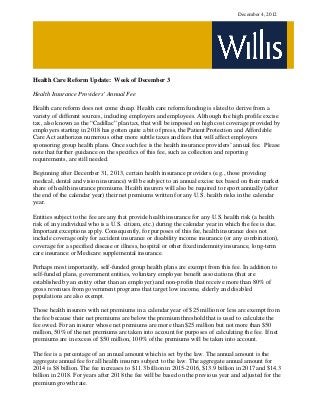
Healthcare Reform Developments week of December 3 2012
- 1. December 4, 2012 Health Care Reform Update: Week of December 3 Health Insurance Providers’ Annual Fee Health care reform does not come cheap. Health care reform funding is slated to derive from a variety of different sources, including employers and employees. Although the high profile excise tax, also known as the “Cadillac” plan tax, that will be imposed on high cost coverage provided by employers starting in 2018 has gotten quite a bit of press, the Patient Protection and Affordable Care Act authorizes numerous other more subtle taxes and fees that will affect employers sponsoring group health plans. Once such fee is the health insurance providers’ annual fee. Please note that further guidance on the specifics of this fee, such as collection and reporting requirements, are still needed. Beginning after December 31, 2013, certain health insurance providers (e.g., those providing medical, dental and vision insurance) will be subject to an annual excise tax based on their market share of health insurance premiums. Health insurers will also be required to report annually (after the end of the calendar year) their net premiums written for any U.S. health risks in the calendar year. Entities subject to the fee are any that provide health insurance for any U.S. health risk (a health risk of any individual who is a U.S. citizen, etc.) during the calendar year in which the fee is due. Important exceptions apply. Consequently, for purposes of this fee, health insurance does not include coverage only for accident insurance or disability income insurance (or any combination), coverage for a specified disease or illness, hospital or other fixed indemnity insurance, long-term care insurance or Medicare supplemental insurance. Perhaps most importantly, self-funded group health plans are exempt from this fee. In addition to self-funded plans, government entities, voluntary employee benefit associations (that are established by an entity other than an employer) and non-profits that receive more than 80% of gross revenues from government programs that target low income, elderly and disabled populations are also exempt. Those health insurers with net premiums in a calendar year of $25 million or less are exempt from the fee because their net premiums are below the premium threshold that is used to calculate the fee owed. For an insurer whose net premiums are more than $25 million but not more than $50 million, 50% of the net premiums are taken into account for purposes of calculating the fee. If net premiums are in excess of $50 million, 100% of the premiums will be taken into account. The fee is a percentage of an annual amount which is set by the law. The annual amount is the aggregate annual fee for all health insurers subject to the law. The aggregate annual amount for 2014 is $8 billion. The fee increases to $11.3 billion in 2015-2016, $13.9 billion in 2017 and $14.3 billion in 2018. For years after 2018 the fee will be based on the previous year and adjusted for the premium growth rate.
- 2. December 4, 2012 The aggregate annual fee is allocated among health insurers and the amount that the insurer pays reflects its market share of U.S. health insurance business. More specifically, the fee equals the amount that bears the same ratio to the aggregate annual fee (as provided above) as (1) the insurer’s net health insurance premiums (that are subject to the fee) for the preceding calendar year bears to (2) the aggregate net health insurance premiums of all covered entities that are taken into account during such preceding calendar year. Example: The following calculation is to determine the insurer’s 2015 fee. Insurance Company A’s net health insurance premiums for 2014 were $2 billion dollars (100% of the premiums are taken into account for purposes of calculating the fee). The total health insurance premiums for all health insurers for 2014 were $100 billion. Based on this information, Insurance Company A’s percentage of the fee is 2%. For 2015, the aggregate annual fee is $11.3 billion. Insurance Company A’s fee for 2015 would be $226 million (2% of the aggregate annual fee). Why should fees generally targeted at insurers be an employer concern? Although such fees are not directly imposed on employers (and self-insured benefits are not subject to the fee), health insurers are fully expected to pass the added expense onto employers in the form of increased premiums and fees.
